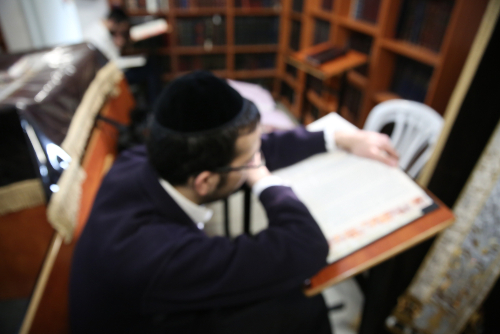When we mix flour and water to make a large batch of dough – about 10 cups of flour, the Torah tells us to separate a small piece and set it aside as something holy.1 When making a larger amount – about 16 cups of flour or more, we make the blessing ‘Asher kidishanu b’mitzvotav v’tzivanu l’hafrish challah min haisa.
The Sages teach that the mitzvah of hafrashat challah (separating dough) brings blessing into our homes.2 While anyone can perform this mitzvah, it’s traditionally done by women. This is because it serves as a tikkun (spiritual repair) related to Chava’s sin with the Eitz Hada’at (Tree of Knowledge).3 Since Chava’s sin took place on Friday, Erev Shabbat, women try to do hafrashat challah, the mitzvah that atones for it, on Erev Shabbat.
Supporting The Kohanim
In ancient times, the piece that was taken off and separated was given to the Kohanim (priests) who served in the Beit Hamikdash (temple). The Kohanim served as the spiritual leaders of the Jews who dedicated their lives to serving Hashem (God). Giving them the separated piece of challah helped support them so that they could devote their lives to spiritual pursuits without having to worry about their livelihood. In those days, more was separated than today. 1/24 of the dough was separated by individuals, and 1/48 was separated by businesses. Today, since we don’t have the Beit Hamikdash, we only take a little piece off and we either burn the piece of dough or, if that is not possible, double wrap it very well and dispose of it.
A Special Time
Shmuel Hanavi’s mother, חנה (Chana) was known for her careful observance of the three mitzvot of a woman, one of which is baking חלה (challah) and doing hafrashat challah. As a result of her careful observance, her prayers for a child were answered.4 Therefore the time of separating challah is an auspicious time to pray for righteous children.
A Channel For Blessing
The simple act of removing a small piece of dough and designating it for Hashem carries with it a weight far beyond the kitchen. According to the Sforno, this mitzvah is not only a remembrance of the Beit Hamikdash and a symbol of gratitude, but is the primary conduit for blessing in the Jewish home.
This idea is echoed in the words of the navi (prophet) Yechezkel:
“Reishit arisoteichem, challah… latet l’kohen, l’hani’ach brachah el beitecha”– “Give your first kneading of dough to the Kohen, so that blessing may rest in your home.”
Yechezkel 44:30
This raises two compelling questions. Why is this mitzvah, of all things, so closely tied to bringing brachah (blessing) into our homes? And why was it specifically given in the aftermath of the cheit hameraglim, the sin of the spies?
To answer these questions, we must understand the dramatic spiritual shift that occurred after that pivotal moment in Jewish history. Before the cheit hameraglim, Klal Yisrael (the Nation of Israel) lived in a world of open miracles. The manna fell from the sky, water flowed from a rock, and Hashem’s presence hovered over the camp. In that elevated state, it was natural, even effortless, to sense that everything came from above. There was no confusion about who sustained them.
A New Saga
However, after the sin of the spies, the nation was no longer deemed ready for such a life. The miraculous existence began to fade, and a new era emerged, one in which Hashem’s daily sustenance of the world would be cloaked in nature. Bread would come not from the heavens, but from the earth, through sweat, effort, and plowing. With that shift came a spiritual danger – the illusion that we are the source of our own success. It is precisely here that the mitzvah of challah steps in.
As the Sforno explains, it was given as a spiritual remedy to that very illusion. In a world where Hashem’s hand is hidden, we are offered a tangible way to declare “This too is from You”. Bread is perhaps the most human of foods, the result of grinding, kneading, and baking, and is also the very thing we are told to share with Hashem. The act of separating challah allows us to invite Him back into our homes, into our efforts, and into our daily lives.
Raising The Mundane
This message is echoed by Rabbi Shamshon Raphael Hirsch, who notes that bread represents the essence of gashmiyut (physicality) because it sustains the body and keeps us alive. When we take a portion of that physical nourishment and designate it as holy, we are stating that our guf (body) exists to serve our neshama (soul).
This idea finds particular expression on Shabbat, when the two loaves at each meal reflect our intent to sanctify even the physical experience of eating. The table becomes an altar, and the meal itself becomes a form of divine service.
Bring Down The Blessing!
Rabbi Chaim of Volozhin offers a deeper perspective on the mechanics of blessing. He teaches that when we perform mitzvot, we awaken spiritual forces above, which in turn draw blessing down below. Through hafrashat challah, in addition to acknowledging the true source of our sustenance, we actually take an active role in drawing that blessing into our homes!
In a post-Meraglim (spies) world, where miracles are concealed and nature seems self sufficient, challah gives us a spiritual tool. It teaches us that while our efforts are meaningful, they are ultimately guided by Hashem’s hand. In this light, the mitzvah of hafrashat challah is an act of spiritual alignment. It transforms the kitchen into a space of avodat Hashem (serving God), and the dough in our hands into a vessel for brachah. By recognizing the true source of our sustenance, we open our homes to a flow of blessing that begins above and enters through the small, holy act of giving a piece back.
Excerpted from Oorah’s Torah Nuggets
Shabbat Meals Part 5 – Sources:
1 Shulchan Aruch Yoreh De’ah 322:2
4 Hagaot Maimanot


